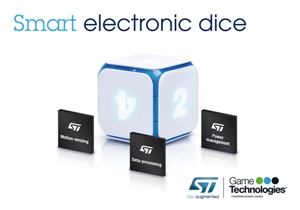STMicroelectronics, a global semiconductor leader serving customers across the spectrum of electronics applications, and Game Technologies S.A. have revealed details of the ST technologies that power DICE+, a revolutionary device that allows people to enjoy digital versions of their favorite board games while allowing them to continue to experience the pleasure and excitement of rolling the dice.

Board games have been a part of human culture for over five thousand years1 but thirty years ago their popularity took a turn as people moved toward the new world of video and PC games. Today, board games are more popular than ever2 and it is the same electronics technology that once threatened them that has powered this resurgence. The traditional physical boards and moveable pieces are increasingly being replaced by virtual boards and pieces displayed on screens that range in size from smartphones to tablets to TVs.
From the start, board games often combined strategy with luck3 and by far the most popular method for introducing chance into board games has been rolling dice. However, generating a random number between 1 and 6 is a trivial task for an electronic device, making dice redundant in electronic games.
Now Game Technologies invented DICE+, a smart electronic dice that uses leading-edge motion-sensing, data-processing, and power-management technologies from STMicroelectronics. Players hold DICE+ in their hands, shake it and roll it, just as they would with traditional dice. The result is displayed on the dice itself for everyone to see. Simultaneously, it is also communicated wirelessly to the mobile device that is hosting the game, eliminating the need to key in the result of the throw. Cheating is not possible; holding the device in a particular position and then rolling it gently to achieve a desired result will not work because this smart dice knows when it has been properly rolled.
DICE+ knows because it has motion sensors and an embedded computing brain that can calculate how many times it has tumbled to decide if this was a fair throw. It doesn’t have an on/off switch, either: leave it alone and it will hibernate; move it and it will spring back into life. All this is possible because DICE+ combines three key technologies: tiny sensors that can detect and measure movement and orientation, microcomputers that are thousands of times more powerful than those that powered the first space explorations, and sophisticated chips that monitor and control the flow of electrical power inside the dice. All of these technologies are supplied by ST.
“Whether the game is being played with physical pieces or on a tablet, a major part of the enjoyment is the moment when the dice is rolled and everybody holds their breath and waits for it to settle. And everyone who rolls a dice hopes that if they throw it right they will get the result they want,” said Patryk Strzelewicz, Board Member at Game Technologies S.A. “We chose ST as our key technology supplier because they offered best-in-class solutions in all key areas and, because they were all available from the same supplier, we benefitted from focused, committed application support.”
ST is supplying four key devices in DICE+: a combined 6-axis accelerometer/ magnetometer to detect and measure movement and orientation, an ultra-low-power STM32 microcontroller for the computing brain, a chip that monitors and controls the charging of the integral Li-ion battery, and an ultra-low-current linear voltage regulator that supplies the correct operating voltage to all the other devices.
“We were delighted to support Game Technologies in this project,” said Benedetto Vigna, Executive Vice President and General Manager of ST’s Analog, MEMS & Sensors Group. “The combination of low-cost sensors, embedded intelligence, and smart power management is enabling creative customers to bring waves of new applications to the market.”
About Game Technologies
Game Technologies was founded by enthusiasts of board games from Q-workshop, one of the world’s largest manufacturers of dice established in 2004. Recapitalised with a $10 million investment, Game Technologies was transformed into a joint-stock company with manufacturing plants and development centres in Europe. At present, the company employs more than 80 people in its offices in the EU, US and Far East, developing new products and applications. The colours in our logotype have a deeper meaning – they symbolise components used in our products. Technology, Materials, Software – each of them is of top quality because our products are designed with attention to details.
1 Examples of a board game called Senet have been found in Egyptian tombs over 5000 years old.
2 According to the Wall Street Journal, (“Classic Board Games Win New Fans in Tablets and Online”), many of the top-selling mobile apps today are electronic versions of classic board games.
3 Senet involved dice-rolling, while Patolli, a 2000-year old Mesoamerican game, involved tossing 5 or 6 black beans, each with a white spot on one side, and counting the number that landed with the white spot showing.